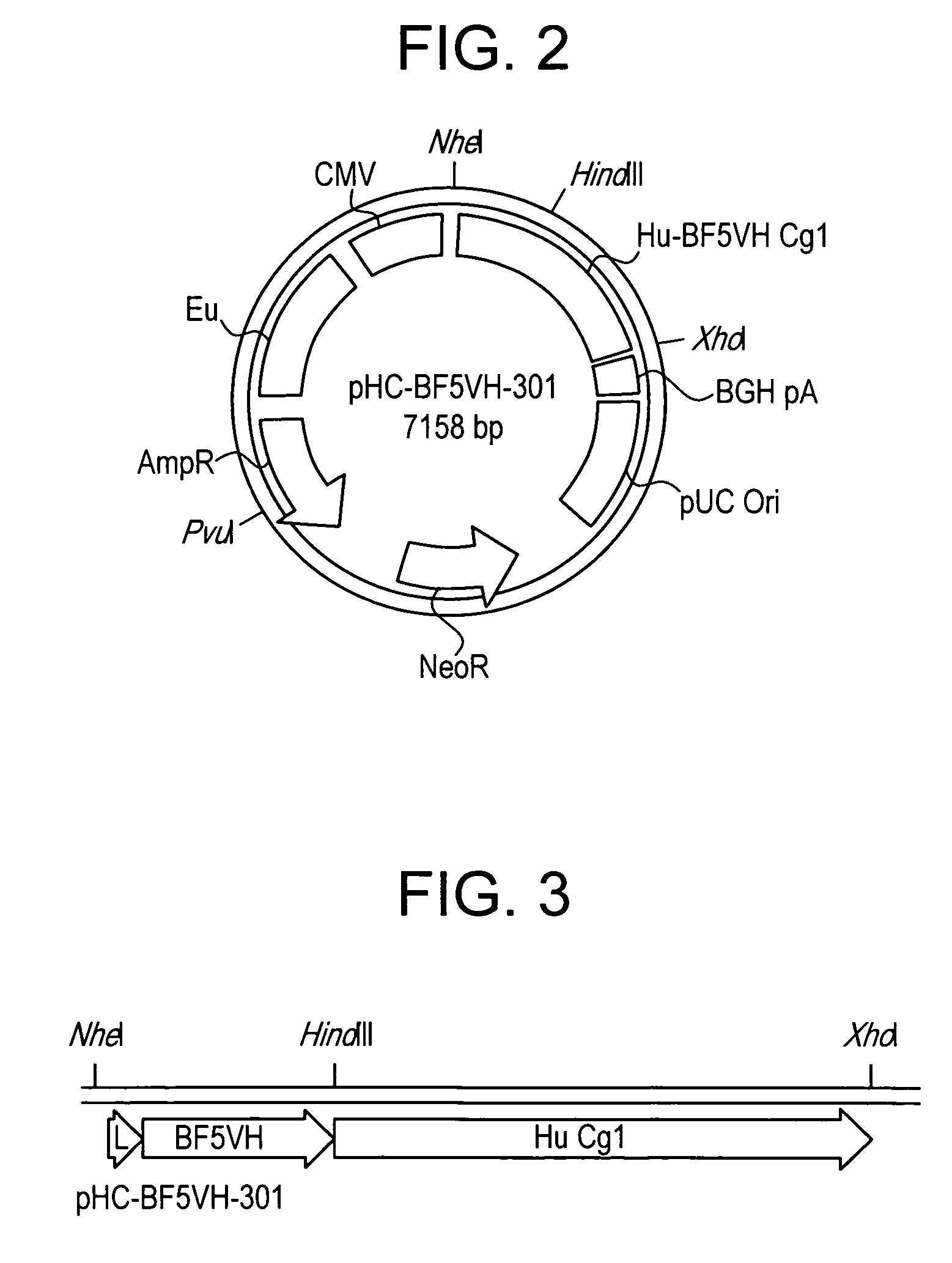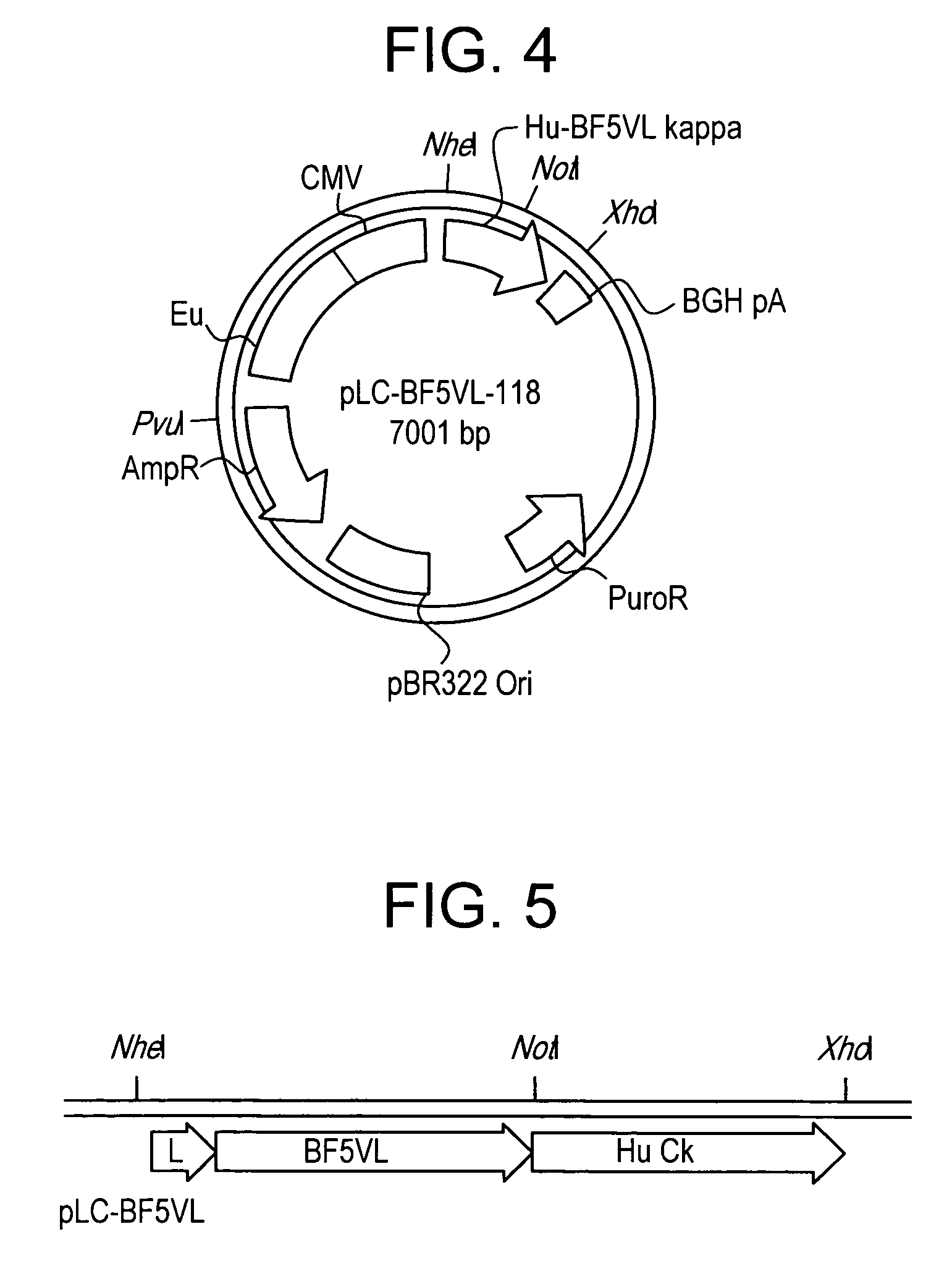Recombinant chimeric human anti-botulinum antibodies
- Summary
- Abstract
- Description
- Claims
- Application Information
AI Technical Summary
Benefits of technology
Problems solved by technology
Method used
Image
Examples
example 1
[0073] Detection of Recombinant Human Anti-Botulinum IgG Antibodies
[0074] YB2 / 0 myeloma cells were transfected with heavy and light chain immunoglobulin plasmids (FIGS. 2 and 4, respectively) to create a recombinant human anti-botulinum toxin antibody from the variable regions of a mouse anti-botulinum Fab. The light chain expression plasmid was linearized by Pvu I digestion, transfected into YB2 / 0 cells by electroporation and selected by puromycin to establish a puromycin resistant population of transfectants. Human kappa light chain was detected in the supernatant of the puromycin resistant population by ELISA. Pvu I linearized heavy chain plasmid was then transfected into the kappa light chain producing, puromycin resistant population by electroporation. Selection of transfectants with both puromycin and geneticin established a dually puromycin and geneticin resistant population of cells. Supernatants from this population tested positive for the presence of human anti-botulinum ...
example 2
[0076] Characterization of Recombinant Human Anti-Botulinum IgG Antibodies.
[0077] Recombinant clones Y1-BF5-A6 and Y1-BF5-B1 were transferred for growth in INTEGRA bioreactor flasks. Supernatant was collected over 4 weeks and purified by G-protein HPLC. The antibody fraction from the protein G column was collected, concentrated and protein concentrations determined. The purified antibodies, rHu-BF5-A6 and rHu-BF5-B1, were examined for binding to the botulinum toxoid by direct and capture ELISA.
[0078] In the direct ELISA, the purified recombinant antibodies demonstrated binding to a 1:100 dilution of botulinum toxoid over a range of antibody concentrations from 10 ug / ml to 1.25 ug / ml (FIG. 7). Using the lowest antibody concentration, this correlates to a detection limit of 9.4 ng botulinum toxoid A and 11.8 ng botulinum toxoid B in our direct ELISA assay. Direct ELISA of recombinant antibodies against individual Bot A or Bot B toxins indicated that the antibodies retain specificity...
example 3
[0081] Comparison of Recombinant Human IgG Antibodies to Mouse BotFab5
[0082] The purpose of these studies was to create a recombinant human IgG antibody that could perform equal to or better than the parent Fab. Therefore, after verifying that the myeloma cells were indeed producing whole human IgG antibodies against botulinum toxoid, it was important to compare the recombinant antibodies to the parent Fab in our diagnostic assays. Comparing the recombinant antibodies to the Fab in a direct ELISA is not feasible because the two reagents would require separate conjugated antibodies for detection. Therefore the recombinant antibodies and the Fab were examined for binding ability to Botulinum toxoid in a capture ELISA. By this means, the plates are exposed to the exact same antigen and conjugated antibodies. Both rHu-BF5-A6 and rHu-BF5-B1 performed better than the BotFab5 at capture concentrations of 2 ug / ml (FIG. 10) and 0.5 ug / ml.
[0083] Discussion
[0084] BotFab5 is an anti-botulinu...
PUM
| Property | Measurement | Unit |
|---|---|---|
| Composition | aaaaa | aaaaa |
Abstract
Description
Claims
Application Information
 Login to View More
Login to View More - R&D
- Intellectual Property
- Life Sciences
- Materials
- Tech Scout
- Unparalleled Data Quality
- Higher Quality Content
- 60% Fewer Hallucinations
Browse by: Latest US Patents, China's latest patents, Technical Efficacy Thesaurus, Application Domain, Technology Topic, Popular Technical Reports.
© 2025 PatSnap. All rights reserved.Legal|Privacy policy|Modern Slavery Act Transparency Statement|Sitemap|About US| Contact US: help@patsnap.com



